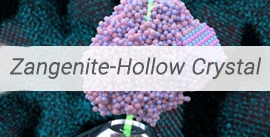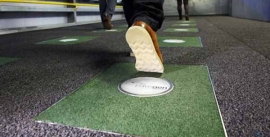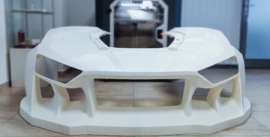 جدید
جدیدساخت هواپیماهای سبکتر با آلیاژ جدید آلومینیوم قابل چاپ ۳ بعدی! ۳D-printed alloys could lead to lighter planes that fly further
آلیاژ جدید آلومینیوم
ساخت هواپیماهای سبکتر با آلیاژ جدید آلومینیوم قابل چاپ ۳ بعدی!
۳D-printed alloys could lead to lighter planes that fly further
دانشمندان بر این باورند که با ساخت آلیاژ جدید قابل چاپ سهبعدی میتوان هواپیماهایی ساخت که با همان مصرف سوخت متعارف مسافت بیشتری را طی کنند.
——————————————————–
ترجمه از گروه ترجمه ایران مواد
حرفه ای ترین تیم ترجمه مهندسی مواد کشور
———————————————————
قطعات هواپیماهای آلومینیومی امروز به علت ضعف این فلز در فرایند جوشکاری و احتمال شکستگی پس از خنک شدن با هزاران قطعه پیچ و پرچ به یکدیگر متصل میشوند.
فلز آلومینیوم با تمام ویژگیهای مثبتی که دارد متاسفانه در فرآیند جوشکاری به شدت ضعیف میشود و تحت پدیده اختلاف گرمای ناشی از جوشکاری به سرعت ترک بر میدارد.
محققان لابراتوار HRL در کالیفرنیا برای اولینبار توانستند دو آلیاژ بسیار مقاوم آلومینیوم را با استفاده از فناوری چاپ سهبعدی به شکل بدنه هواپیما چاپ کنند.
دو آلیاژ ساخته شده در این لابراتوار نه تنها برای ساخت هواپیما مناسب است بلکه برای تولید بدنه اتومبیل و کامیون نیز ایدهآل است.
محققان معتقدند که با استفاده از آلیاژ جدید دیگر نیازی به پیچ و پرچ جهت اتصال قطعات آلومینیومی نیست و این ویژگی نه تنها استحکام اتصال قطعات را دو چندان میکند بلکه با کاهش قابل توجه وزن هواپیما، دامنه پیمایش با همان میزان مصرف سوخت افزایش مییابد.
ساخت آلیاژ جدید آلومینیوم در این مرکز تحقیقاتی از نانو ذرات زیرکونیوم با فرایند اتصال از طریق پرتودهی لیزری انجام شد.
پوشش نانو
حربهی این تیم پژوهشی، پوششدهی ذرات فلز با نانوذرات ویژهای که جوانهزایی کرده و چهارچوبی از ریزساختار مطلوب آلیاژ ایجاد میکنند و حرارتدهی لیزری و سپس انجماد فلز، بوده است. در هنگام سرمایش، مذاب فلز از الگوی ایجاد شده توسط این نانوذرات پیروی کرده و به این صورت از ایجاد ترک در آلیاژ جلوگیری میشود. این بدان معنی است که قطعهی نهایی استحکام کامل فیزیکی خود را حفظ میکند.
برای یافتن نانوذرات مناسب، محققین تعداد زیادی از عناصر را مورد بررسی قرار دادند که در نهایت نانوذرات بر پایهی زیرکونیوم، برگزیده شد.
زیرکونیوم گران نبوده و در این مورد نیز تنها وظیفهی آرایش بخشهای هر ذره را بر عهده دارد. در واقع از این طریق با هزینهای متوسط، به کاربردهایی گرانبها دست مییابیم.
هواپیماهای ساخته شده از آلومینیوم به طور قابل توجهی سبکتر هستند و در هواپیماها، وزن معادل با هزینه میباشد. یک بدنهی سبکتر، این اجازه را به هواپیماها میدهد که با میزان سوخت یکسان، مسافت بیشتری را پرواز کنند.
منبع: www.newscientist.com
مترجم : امیر اشجاری
۳D-printed alloys could lead to lighter planes that fly further
A new process for 3D-printing things could pave the way for lighter, faster aircraft that potentially fly further on the same amount of fuel.
Today’s aeroplanes are held together with thousands of metal rivets and fasteners. That’s because the lightweight but strong aluminium alloys used for their frames are considered unweldable. Try to weld them and you get a phenomenon called hot-cracking, in which the finished alloy weakens and fractures as it cools.
This and other adverse welding effects also stand in the way of 3D-printing high-strength aluminium alloy parts. When researchers have tried, the resulting laser-fused mass flakes away at the welding area like a stale biscuit.
Yet that looks set to change soon. Researchers at HRL Laboratories in Malibu, California, seem to have overcome this long-standing problem, after developing a way to 3D-print the two most commonly used types of high-strength aluminium alloys.
These alloys are not only highly desirable for aircraft, but also for cars and trucks. In addition, the method opens up the possibility of using 3D-printing processes in a similar way to create high-strength steels and nickel-based superalloys.
Nano-coating
The team’s trick was to coat the metal particles with specially selected nanoparticles that seed and create a framework of the desired alloy microstructure as the laser-heated metal solidifies. As it cools, the molten alloy follows the crystalline pattern set by these nanoparticles, preventing hot-cracking. That means the final, manufactured part retains its full physical strength.
To find suitable nanoparticles – specifically, zirconium-based nanoparticles – the researchers sorted through the myriad possible elements on the periodic table to find the one with the right properties.
Zirconium is not particularly costly, and in this case only makes up part of each particle. The moderate manufacturing costs would be justified by the high-value applications.
Welded aluminium aircraft could lead to significantly lighter aeroplanes – and when it comes to aeroplanes, weight translates to money. A lighter frame may allow aircraft to fly further on the same amount of fuel.










دیدگاه کاربران
ترجمه ها بسیار خوب است.ممنون